Nerdcation 2014: The Midwest
When I was a college-aged intern, a very wise supervisor told me that opportunities are everywhere -- but most people never look for them. I mostly apply that wisdom to vacations. I have a custom Google map marking all the historic sites I want to see. When life demands my presence in a particular part of the country, I check the map, run the numbers and see what's within a reasonable distance.
This is all normal behavior and I should not be judged for it.
A friend decided to get married in 2014, and per the usual custom he decided to have a bachelor party. Per a very unusual custom, he wanted to have it in Milwaukee. The map told me that if I stretched the definition of "reasonable," I could see a lot of things, very quickly. Nerdcation 2014 was the result. Starting in Omaha, I traveled through Iowa (Des Moines, West Branch and Cedar Rapids), Illinois (Galena, Tampico and Dixon) and Wisconsin (Beloit and Milwaukee). The notes are below.
August 20, 2014
The (Other) Wizard of Omaha
Apparently, the nicest thing you can say about Leslie Lynch King is that his parents had money. The Kings accumulated all kinds of wealth from banking and other sordid activities. That undoubtedly helped Leslie score a hot lady named Dorothy Gardner. Once Dorothy was properly knocked up, she and Leslie moved into the King family home, in the tony Omaha neighborhood of Hanscom Park.
Dorothy, being an observant lady, soon realized that her husband was an abusive drunk. Their son was born on July 14, 1913. Dorothy skipped town two weeks later, after Leslie expressed his slight reservations about fatherhood by threatening his wife and newborn with a butcher knife. She got a divorce -- which was still a big deal in the early 20th century -- and wound up in Michigan with her own family. Her son eventually took the name of his stepfather, Gerald Rudolph Ford.
Nice twist, right?
It's not an easy thing to memorialize domestic violence, but in the interest of presidential history the good people of Omaha have tried. The Ford Birthsite and Gardens occupies the site where the King home used to be. My travels have never taken me to Omaha -- Warren Buffett and I do all of our business over the phone -- so I intentionally started a Midwestern road trip there for the express purpose of seeing this fine patch of dirt.
But if you're in Omaha, you really should make the most of it. I flew in on a Tuesday night and stayed at a fine Motel 6. Inspired by the fine brochure rack, I started Wednesday with a trip to Boys Town, which is a story unto itself. Father Edward J. Flanagan was an Irish-immigrant priest. He started a home for wayward lads, regardless of their race or creed, or the race or creed of anyone they stabbed. It eventually moved west of downtown Omaha, to a property that was sort of rural at the time.
About 20 years into his project, MGM made a movie based loosely on Father Flanagan, and Spencer Tracy won an Oscar playing the priest. My grandfather, an Irish Catholic, liked it. When he joined the Army in World War II, one of his assignments found him driving in a convoy between two bases in the Midwest; he was thrilled to wake up one morning and discover that they had parked just across the street from Boys Town. It was one of his favorite memories of the war, recounted even more fondly than the time the Japanese bombed his base on Saipan on Christmas Eve. Go figure.
The area around Boys Town has a few more strip-mally qualities these days, but the campus is still there, and the school is still going strong. I didn't have a full-blown tour, but it was nice to drive around, see a few of the buildings and think about Pop Pop being there seven decades ago. They have a fine statue that is a tribute to either piggy-back rides or Christian brotherhood.
After that, I drove east with the commuters into the thriving insanity of downtown Omaha. It's not all that bustling, but I did go past the Mutual of Omaha building, which gave me the chance to reflect on how few people have seen "Wild Kingdom." Turning south, I passed through a few more average-looking neighborhoods before getting to Hanscom Park. It's less ritzy these days, but still very pleasant. It's also entirely residential, so I parked in front of some slob's house and skipped across the street to frolic on the spot where the 38th president was born.
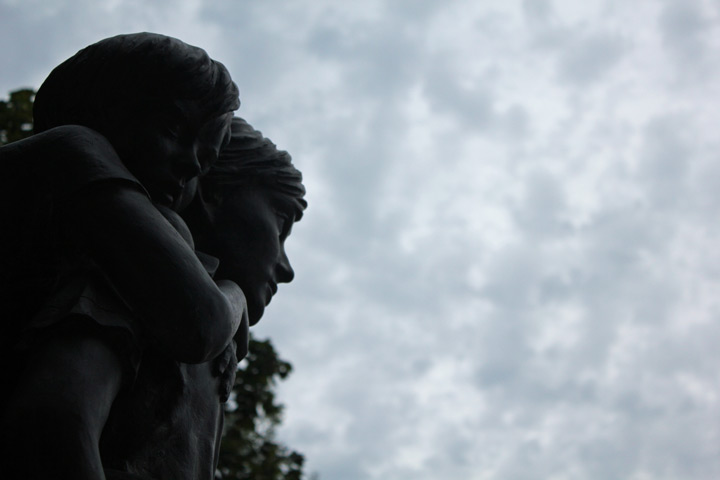
He ain't heavy, he's my brother! A statue at Boys Town.
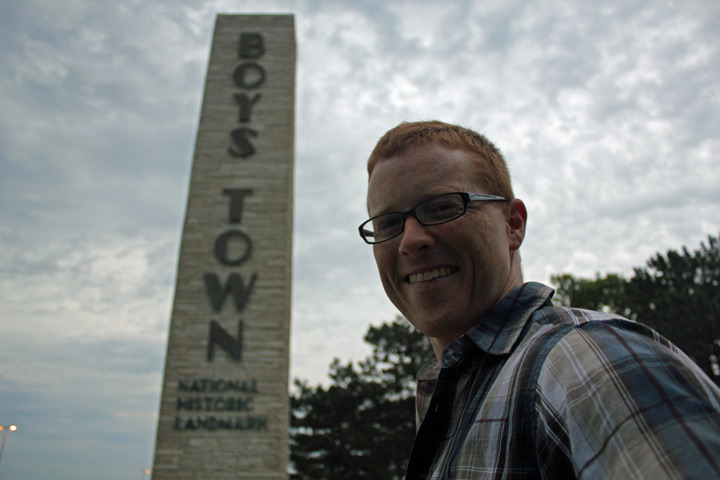
Making granddad proud with a vistit to Boys Town.
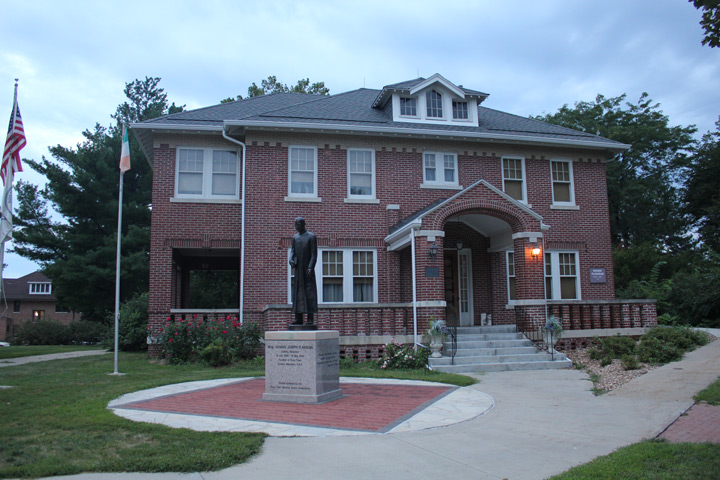
The campus at Boys Town, the famous home for wayward youths.
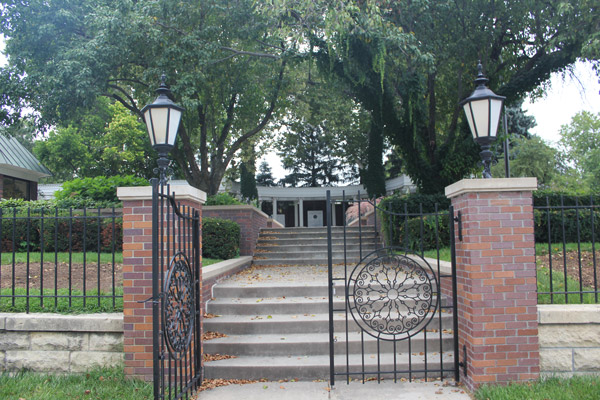
The garden of Leslie delights awaits you.
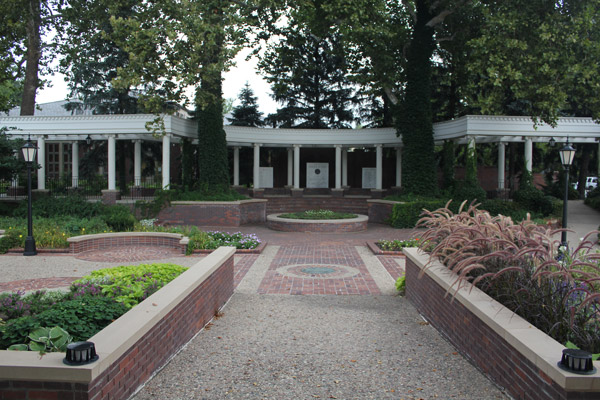
Inside the gates, looking at the Ford pergola. Which isn't an off-brand car, I swear.
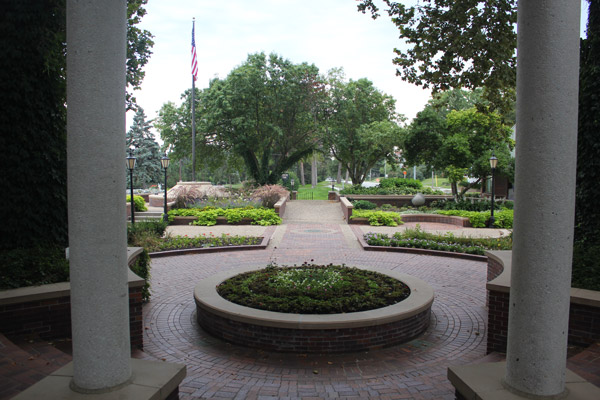
Under the pergola, looking out. You know what's fun? The word "pergola."
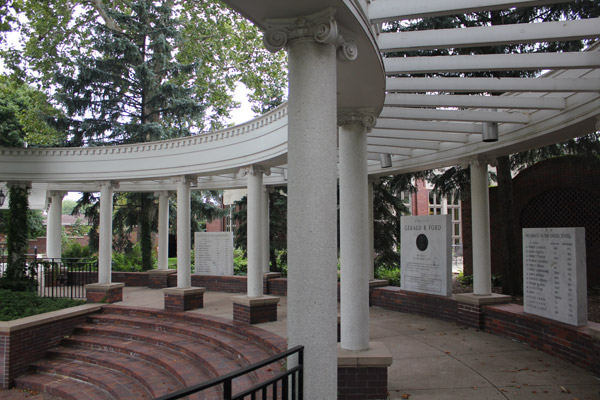
It's Nebraska, but the site is more sincere than corny.
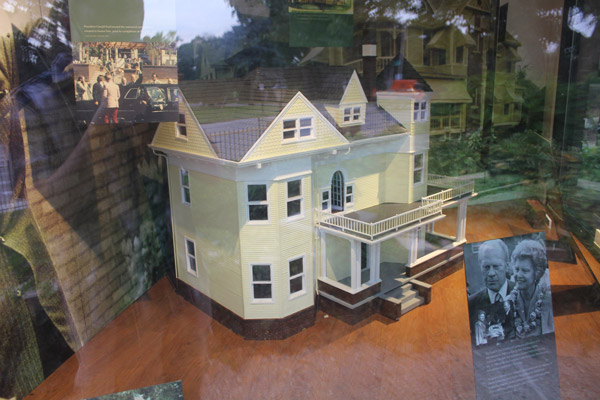
A model of the old King house, which was Ford's home for about two weeks.
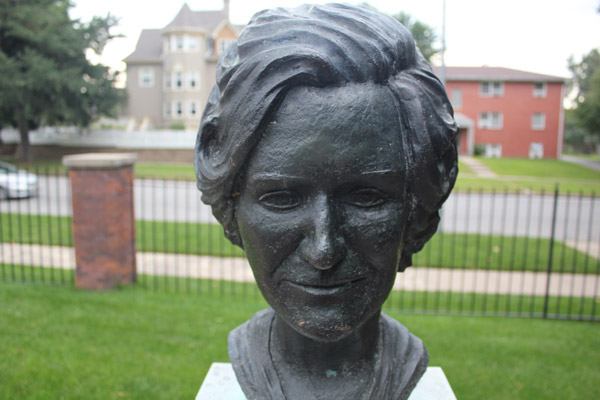
Betty also gets her props at the Ford birthplace.
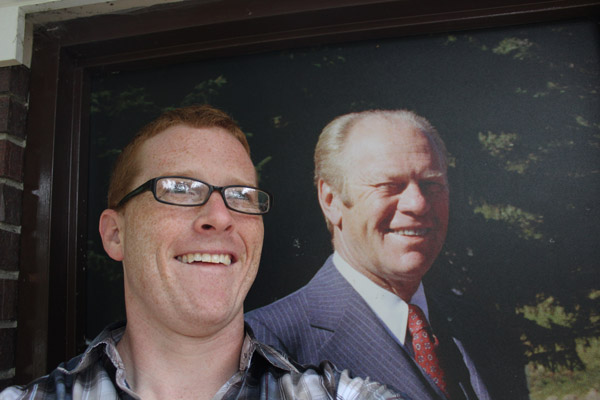
For a guy who had the names "Leslie" and "Rudolph," he was a pretty cool dude.
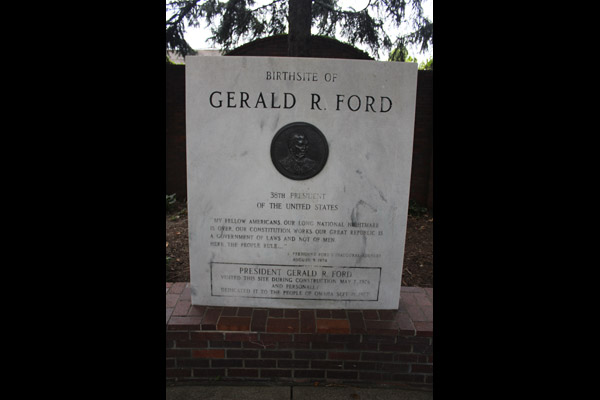
The marker that ties it all together. Nice!
It's actually very nice. A local businessman bought the property in 1974, when Ford took over for Nixon. Ford is commemorated with a stone marker underneath a pergola. On either side are tablets listing the birth state of every U.S. president. (In case you were wondering, Obama apparently comes from Hawaii. Who knew?) There's a rose garden to honor Betty Ford, and for good measure they threw in a few more stone tablets listing every Nebraska governor and Omaha mayor, because apparently someone had a good deal on granite markers. A nice kiosk gives an overview of Ford's presidency; it also has a model of the birth house.
The whole site glosses over the less-savory aspects of the Leslie King story, but apparently Ford was pretty gracious about the whole thing. He didn't have any meaningful experiences in Nebraska after he was whisked away. He couldn't have had any real attachment to Omaha, outside of enjoying the occasional steak. But he showed up for a dedication ceremony and said some nice things about the city. He was that kind of guy.
Of all the relatively meaningless presidential sites I have visited, this was definitely one of the best.
Corn Palace
Iowa has many virtues, but one of its very best features is consistency. East to west, north to south, each acre is more or less the same as the last -- there are farms, occasional wind turbines and small towns with names like "What Cheer." If you're driving east from Omaha on I-80, the highway is so straight that you can set the cruise control and take a nap. In the worst case scenario, you'll drift into a corn field and gently roll to a stop.
I wasn't sure how to activate the cruise control on my rental car, so a nap was off the table. I needed another productive way to round out my morning. Before long, I started seeing signs for Des Moines. Drawing on my vast public school knowledge, I remembered that there might be a fancy building there. Traditionally, there are road signs pointing to such things, so that passing citizens know where to redress their grievances. I took the highway headed closest to downtown, and before long I was pulling up in front of the Iowa state capitol.
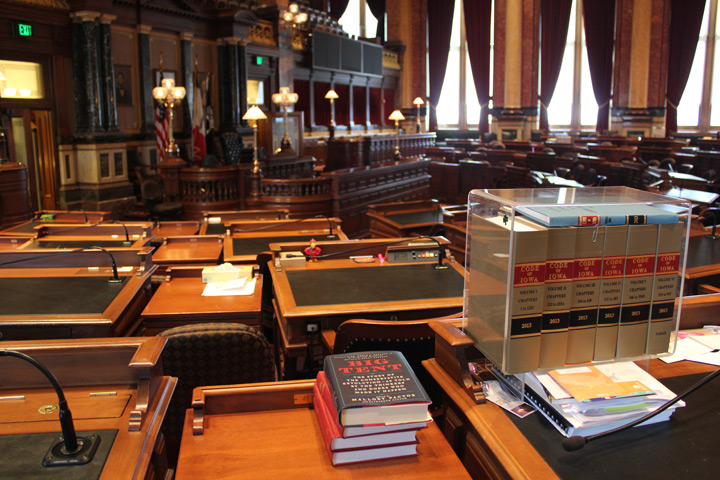
Seeing how laws are made in Iowa, at the very nice capitol.
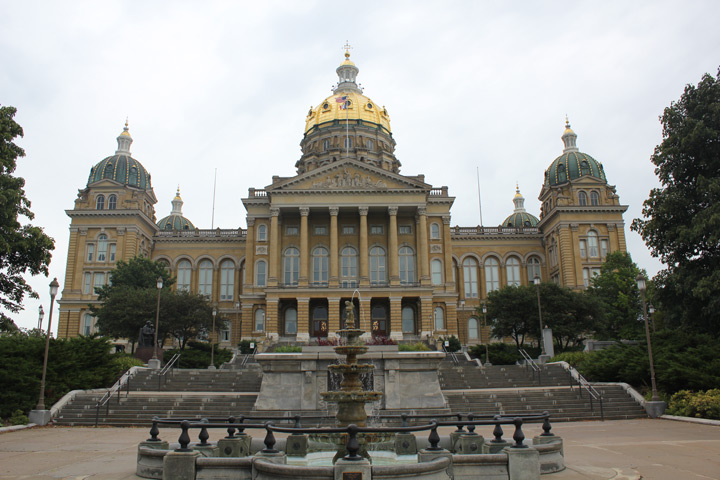
An outside view of the Iowa Capitol and its iconic golden dome.
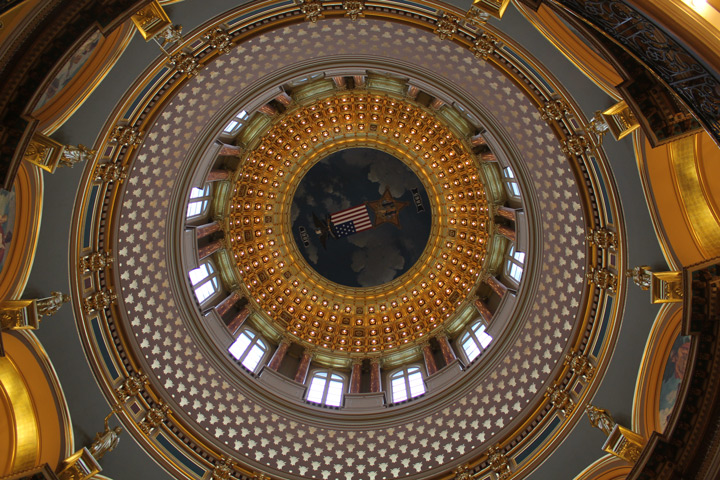
Things are looking up. The interior of the capitol dome, seen from the rotunda floor.
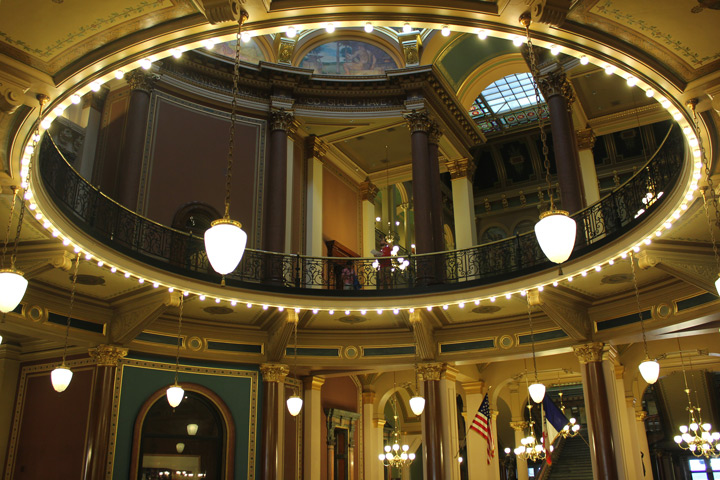
A cool halo in the capitol rotunda.
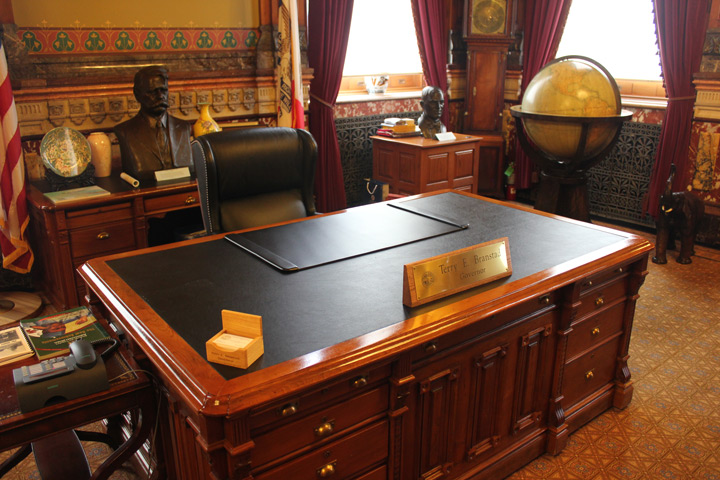
The governor was out but his desk was in.
You may have seen it before. Every four years, the people of Iowa enjoy lording over the nation as the self-appointed judges of anyone who wants to be president. Political careers have been shattered because some East Coast senator couldn't connect with a guy in Coon Rapids who sells supplies to hog farmers. When this happens, national media outlets use the capitol as their headquarters, broadcasting mildly incoherent analysis from inside the building.
It's a great place. No state has been bold enough to put its capitol at the bottom of a ravine, so Iowa's sits on a hill overlooking all of Des Moines. It was designed by a guy named Alfred Piquenard, who died 10 years before the building was finished in 1886. He supposedly wanted a building that would last many centuries, through the dawn of the Iowa Galactic Imperium. It has five domes, and the central one is gilded -- once a generation, the people of Iowa pay for a new layer of gold 250,000th of an inch thick. There's a nice statue in front of the building with a figure representing the brave pioneers who reached Iowa and said "Eh, far enough." There's also a curious statue of Abraham Lincoln with his youngest son, Tad. It represents people not having better statue ideas.
The inside is no less impressive. I walked into the basement entrance a few minutes before a tour. It was me, a helpful guide, and the usual group of people who might tour a state capitol on a Wednesday morning in the summer -- i.e., retirees who ask terrible questions and move very slowly. One day I will be one of them.
Every surface of the interior is an artsy-craftsy masterpiece. In the 19th century, the architects and foremen had access to an amazing class of day laborers, many of them Old World craftsmen who could be retained for years at a time. There are amazing patterns in the marble floors, and hand-carved woodwork is all over the place. Most of the walls have intricate stencils, and there are currently restoration artists keeping those stencils beautiful.
Iowa's legislature is part-time, as most of its elected officials must also tend to large fields of corn. So the building was basically empty for the summer. We got to see the House and Senate chambers and the governor's office. The most amazing room is the stunningly beautiful law library, which looks like the kind of room where the protagonist in a Jules Verne novel would deliver six pages of exposition.
All you need for democracy is a room with an open floor plan, a legal pad to write down the votes and some low-cost rental housing where legislators can conduct their extra-marital affairs. There's something wonderful and depressing about Iowa going the extra mile. On the one hand, it's an excellent thing to see in person. On the other, there's the knowledge that such buildings are probably a thing of the past. Domes won't be gilded, and no government will justify the hiring of hundreds of immigrants who know how to use a lathe. The problem with moving forward is that it takes you away from some good things, too.
The point is, I miss the elegance of rail travel. And why does no one have beef stroganoff on the menu anymore?
Herbie the Love President
By most accounts, Jesse Hoover was a decent guy. His family settled in West Branch, Iowa, in 1854. He married a fine Canadian immigrant named Hulda in 1870 and set up a blacksmith shop the next year. The nearby railroad guaranteed a steady stream of clients, and before long he was selling farm implements to the many hardworking hayseeds that populated the Midwest. He also fathered three children, raising them in the Quaker tradition.
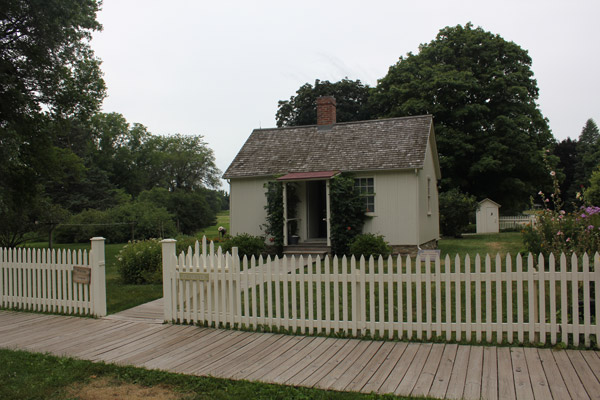
The blessed shed where our 31st president was born.
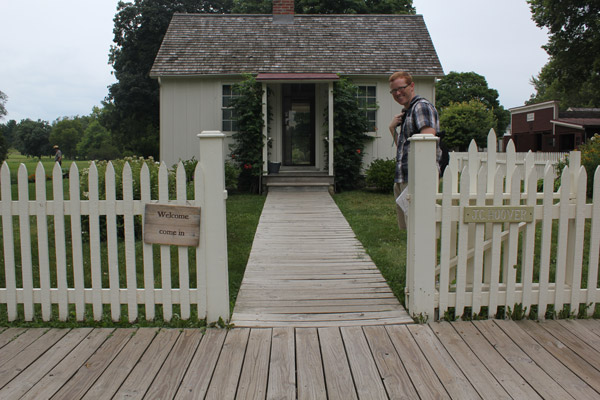
From this beginning, he became mind-bogglingly wealthy. Fun!
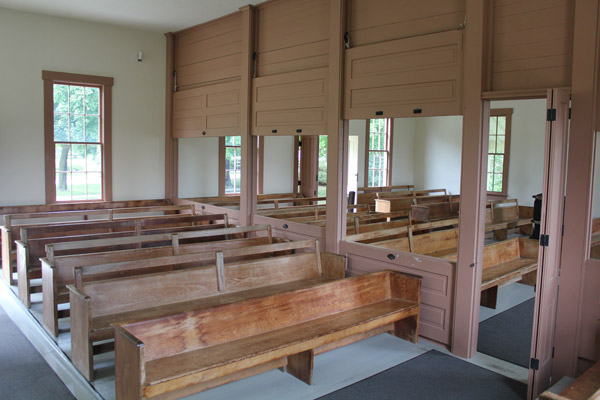
Inside the Quaker meeting house. The site gives a crash course on Quaker culture.
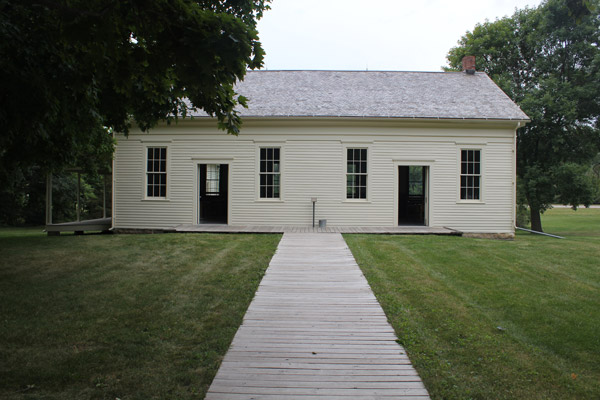
The outside of the Quaker meeting house. So sexy.
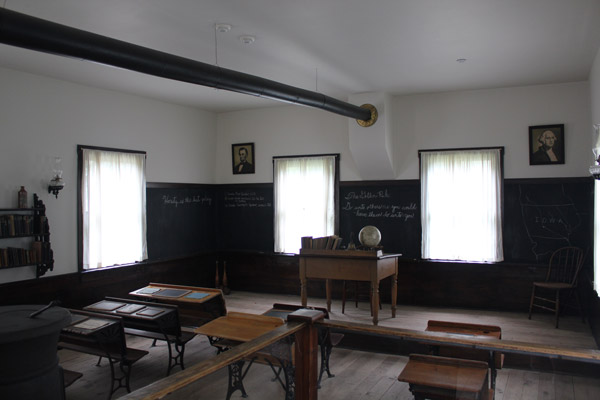
The schoolhouse in the preserved Quaker village.
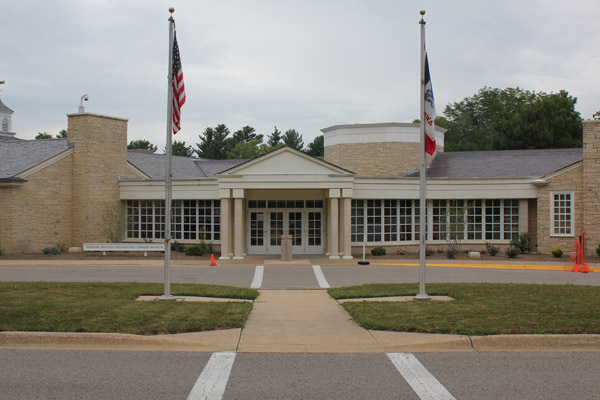
Heading into the NARA library and museum.
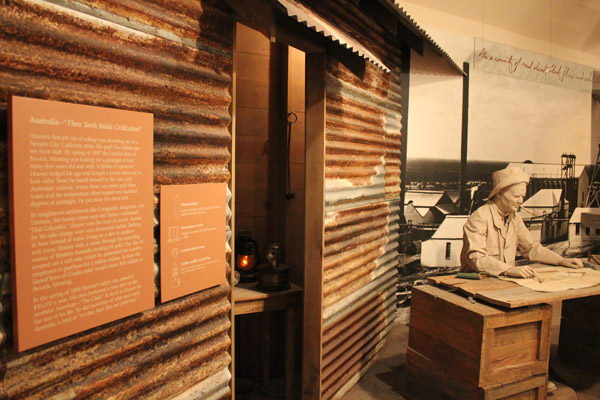
Exhibits on Hoover's mine engineer days, complete with creepy mannequins.
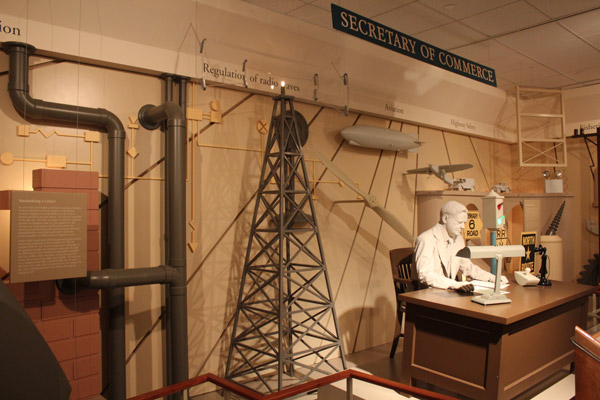
The secretary on the job. Easily, the finest Commerce secretary ever.
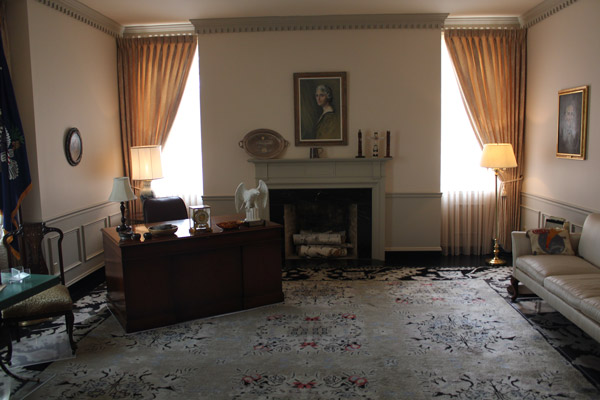
A re-creation of Hoover's office in the Waldorf Towers in New York.

Heading through the meadow toward Hoover's grave.
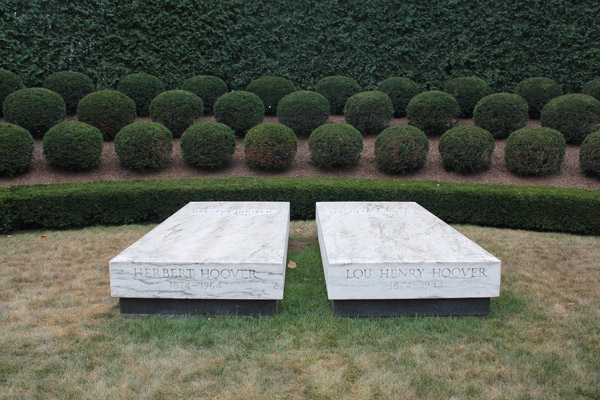
An appropriately Quaker-ish grave for Hoover and Lou Henry.
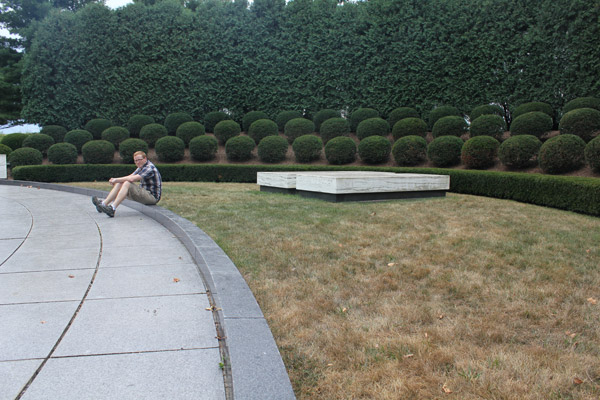
A wider shot of the gravesite. So many topiaries.
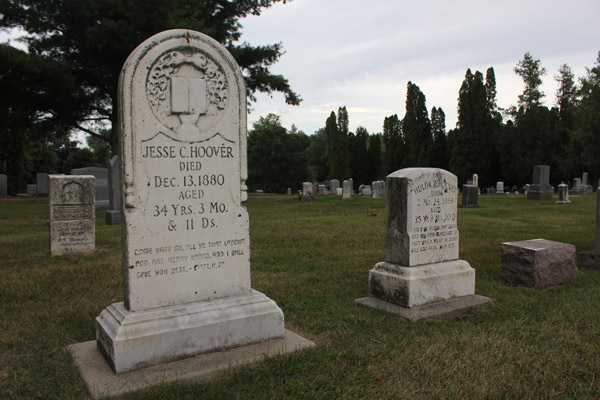
Hoover's parents at the nearby family burial plot.
Jesse squandered all that good will by keeling over from a heart attack in 1880, like some kind of jerk. His widow, Hulda, scraped together enough money to keep the family afloat. They took on boarders, stayed with relatives as needed and carefully spent they payout from Jesse's life insurance policy on the children's education. But Hulda loved her husband dearly, and she ultimately decided to honor his memory by keeling over from typhoid fever in 1884.
Those lazy bums got to rest eternally in the West Branch Municipal Cemetery, but their children had to soldier on. Overcoming the terrible example of his quitter parents, their middle child even did pretty well for himself. Herbert Hoover wasn't the best president, but he might have been the most interesting person to become president. His journey started in West Branch, and thanks to some forward-thinking Hoover fans and the National Park Service, there's actually something to see there.
The centerpiece is the birth cottage, where the magic began on August 10, 1874. The Hoovers had a tiny place not far from Jesse's blacksmith shop; it was surrounded by a smallish lot and backed up on a creek. The building you're seeing today is legit -- when Hoover got famous, it had been preserved by a curmudgeonly owner and shown to gawking visitors at 10 cents a pop. Hoover's wife, Lou Henry, acquired it in an estate sale when that curmudgeon finally died.
By the time Bert's sister came along, there were five people in two rooms, and neither room was big. Even by the smelly and cramped standards of the 19th century, things were getting to be barbaric, and family moved to a larger home across the street.
That second home is gone, but there's a surprising amount of 19th-century West Branch remaining. The park service maintains a tidy little historic district -- a few blocks where every home and structure is either original to the era of Hoover's birth or damn close to what baby Bert would have seen. The streets are dirt and the sidewalks are wooden boardwalks. You can't barge into neighbors' homes, but there's a Quaker meeting house to see, and a replica blacksmith shop, and a one-room schoolhouse.
The site also has park rangers, who will tell you in great detail what all the buildings actually mean, in the profound life-shaping sense. The school reflects the Quaker commitment to education. Hoover was a fine student and among our nerdiest presidents. The blacksmith shop reflects Hoover's early exposure to practical problem-solving. As the only engineer president, he had a methodical approach to government intervention. The meeting house represents Quaker values; Hoover had very specific ideas about charity, service and community that helped him becpome the most famous man in America.
After ma and pa Hoover kicked the bucket, Bert and his siblings were passed off to relatives in West Branch. But John Minthorn, an uncle on the West coast, suffered through the death of his only son. He requested Bert as a replacement, and before long Bert was on a train heading to Oregon.
You can pick up the rest of the story at the nearby Herbert Hoover library and museum. It has fine displays walking any visitor though the triumph and tragedy of Herbie, the love bug:
- Hoover's studies take him a brand-new college known as Stanford, where he gets a degree in geology and meets fellow rock enthusiast Lou Henry.
- Early work takes him to Australia, and not the quaint, civilized parts; he lives in the wilderness with a bunch of yabbos and starts developing a reputation as the "doctor of sick mines."
- Making a ridiculous salary, he gets transferred all around the world. He and Lou Henry were in China during the Boxer Rebellion, when shells regularly rained down on their home. Hoover was a guide to the troops that eventually showed up and led efforts to protect all the civilians.
- Almost insanely rich at the time of World War I, he goes full-on Quaker and starts using his amazing logistics abilities to run aid to Belgium, saving many thousands of people and becoming a cultural hero. He would only be surpassed in hearts of Belgians by Jean Claude Van Damme.
- In 1917, he is put in charge of the U.S. Food Administration, where he inspires the wartime nation to sacrifice with Meatless Mondays, Wheatless Wednesdays and Frogurtless Fridays. This economizing became known as "Hooverizing," giving parents everywhere a fun new way to tell their kids that they can't have hot dogs and need to shut the hell up.
- Warren Harding makes Hoover the secretary of Commerce, and he soon becomes the most active and popular cabinet secretary in all the land. His quest for standardization across industries make him a prominent regulator of broadcasting, railroads and more; he makes the case for massive hydropower projects; and he coordinates a giant private-sector relief effort after the Mississippi River floods. Calvin Coolidge (who disliked Hoover and called him "Wonderboy") decides not to run for a second full term, and Hoover locks down the 1928 nomination within months.
And they all lived happily ever after.
HA! The Great Depression kicked off about the same time as Hoover's presidency. There are a number of theories as to why he screwed up, and they're all a little bit true. Before becoming president, Hoover had never been an elected official, so he wasn't all that great at politics. Some people wanted an overwhelming and immediate government response to the economic collapse, but Hoover tried to ease into it -- in all his previous disaster relief efforts, the public sector was mostly a facilitator to help the private sector come to the rescue. Things were spinning out of control so fast, however, that Hoover was painted as a callous jerk. It's also entirely possible that no president could have saved the day, and Hoover was just the guy holding the hot potato.
They cover all this in the museum, as well as Hoover's post-presidency years. Hoover was used a scapegoat by FDR, a remarkably experienced politician who loved bullying people to a pulp. But Truman extended an olive branch, asking Hoover to help reorganize the executive branch. Hoover kept writing and traveling -- he lived into his 90s, and he was active almost all the way to end. Instead of replicating the Hoover Oval Office, the museum has Hoover's office at the Waldorf Towers in New York City. Later in life, when Hoover was asked how he handled the abuse of the New Deal crowd, he said: "I outlived the bastards."
At least, he did until 1964. Hoover chose to be buried in West Branch, and the grave is within sight of the cottage where he was born. There's nothing too fancy about the markers, but there's a nice path taking you there. It cuts through a flower-filled meadow that looks something like an original Iowa prairie before the Quakers showed up and started building small towns. Hoover was a perplexing and complicated guy, but there's something pleasantly simple about his final resting place.
FUN HOOVER FACTS!
- President Hoover was warned that his weight was getting too high, so he invented a sport to stay in shape. It's called Hooverball, and it involves team of people throwing a medicine ball over a volleyball net. Many high-ranking officials were enlisted to play. It is widely considered the second-greatest sport invented by a president, bested only by Teddy Roosevelt's version of polo involving grizzly bears.
- Hoover's engineering career made him very wealthy, and he declined his salary while serving as president. He also decommissioned the presidential yacht. But all anyone wants to talk about is the millions of destitute people starving in the streets. That's media bias for you.
- Lou Henry was a fairly amazing woman, and by amazing, I mean she collected weaponry from around the world. She was also a national leader of the Girl Scouts, but somehow those two passions never came together.
- As the secretary of Commerce, Hoover was featured in the first long-distance TV transmission. Unfortunately, studio executives thought he was too edgy for flyover country and refused to order him to series.
- Hoover was sworn into office by William Howard Taft, who was the Chief Justice of the United States at the time. It is the only time that a one-term Republican president swore in another one-term Republican president. That's the kind of stat you can use to make yourself sound really cool with the ladies the next time you're at a cocktail party.
If You Build It They Will Come
One of the great joys of traveling alone is figuring out what to do with your evenings. Dining alone is a little sad if you aren't a foodie, or rich enough to rent out the entire Arby's. Going to the movies isn't a horrible option, but "Iron Man 3" is the same whether you're watching it in New York or Oregon. It has never been fun to hang around a Motel 6.
Baseball solves all your problems. You get to see a local franchise, you're guaranteed about 3 hours of entertainment and you have the chance to eat something in a setting where no one will point at the guy toasting himself with tears running down his face. Iowa is the home to lots of hot minor league action, and the scheduling gods were smiling on all my travel plans. I left West Branch when the Hoover Library closed, drove west on I-80 for a few miles and turned north for Cedar Rapids.
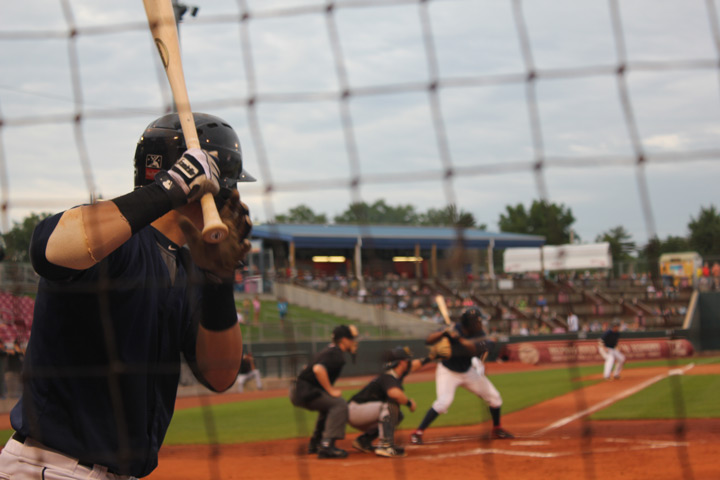
Cedar Rapids, where the air smells of cereal and baseball.
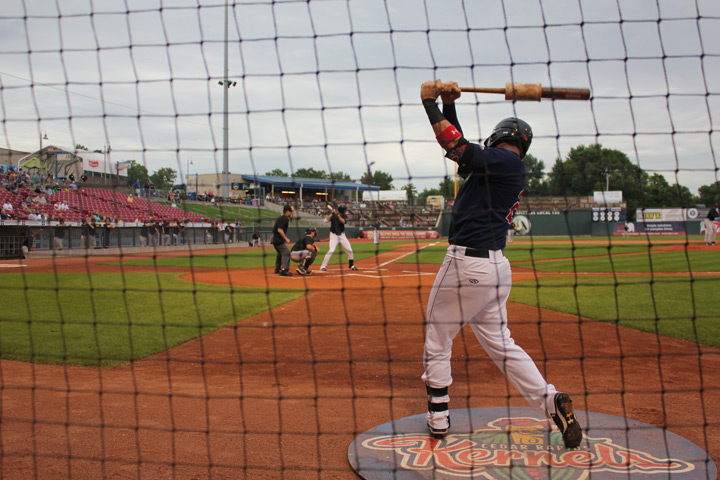
Getting very close to the action at a Kernels game.
The Kernels are currently a single-A affiliate of the Minnesota Twins, playing in the Midwest League. That means the roster is filled with lots of guys almost half my age, and the occasional guy three-fourths my age who had a severe groin pull and needs to get his timing back. Their manager is Jake Mauer, a man nine-tenths my age whose younger brother happens to be the first baseman for the Twins. The Kernels logo is a anthropomorphic ear of corn wearing a baseball cap, which is both amusing and terrifying; their mascot is a guy with a baseball for a head, who has corn husks poking out from his collar.
There's a lot of latitude in the quality control for single-A parks, so I wasn't sure what to expect. The Kernels, like many teams, play in Veterans Memorial Stadium. That means that someone built a ballpark and put a few old tanks or howitzers near the main gate. They sold the naming rights to the field to Perfect Game, a Cedar Rapids-based company that scouts amateur baseball players for college and professional teams. And the stadium ain't bad at all. They have a nice solid concourse, an actual scoreboard and the requisite party pavilions. I bought a ticket online in advance to make sure I had a good seat. It cost less than $10 and it was three rows behind home plate.
I over-planned a little for a Wednesday night in Cedar Rapids. As I was taking a few pictures of the field, two guys in the front row started joking that I was blocking their view. A few minutes later they invited me to join them. Charlie was an insurance salesman, and Bob was a retired federal prosecutor. And as it turns out, Bob's son was the longtime batboy for the Kernels. (He has autism, the job really drew him out of his shell, and the team let him keep the job much longer than usual.) John snagged me a foul ball, which was the first one I have ever received in about 33 years of going to professional baseball games. God bless America.
The Kernels lost to the Astros-affiliated Quad City River Bandits, breaking an eight or nine game win streak. But it was a great evening of talking sports with some friendly guys. We were up against the netting, shading to the first base side. So any time the Kernels were batting, the on-deck player took practice swings right in front of us. For three hours, I had an up-close look at the butts of aspiring major leaguers. All their pants are patched. It's single-A, so you don't get new uniforms when you rip or tear them while doing your job.
There were also some nice flourishes that you only get at minor league baseball. For example, one of the inning breaks was sponsored by a local dentist, so a despondent woman in a tooth fairy getup (a tutu and a tiara) came out and cleaned second base with a giant toothbrush. And I had a sandwich, a 20-ounce beer and a bag of peanuts for the cost of a small soda at a Washington Nationals game.
According to Bob, I wanted to be in Cedar Rapids in the morning, when the General Mills plant starts cranking out the Lucky Charms -- the smell is magically delicious. But I had a motel reservation in Dubuque, where the morning smells are ambiguous at best. After the game I drove northeast and checked into a Motel 6, the single-A of hotel chains. Cigarette-burned sheets aren't replaced. They're lightly washed and placed right back on the bed. It's kind of noble, if you don't think about it.
August 21, 2014
Get the Lead In
When U.S. Grant moved to Galena, Ill., in 1860, he had not yet actualized his potential. He was not yet the very best Ulysses Grant that he could be.
Basically, he sucked.
Grant had faded out of the military. He married the daughter of a Missouri plantation owner, but his father-in-law wasn't one of those cool plantation owners from the movies who two-fisted mint juleps and could shower a deadbeat son-in-law with riches. Instead, Grant scraped by as a mediocre farmer and failed businessman in the St. Louis area.
His own dad came to the grudging rescue. Jesse Grant was a tanner, and back then the leather goods industry was for more than bikers and sado-masochists. One of his sons was operating a leather shop in Galena, which at the time was a fairly big deal. It's not far removed from the Mississippi River, and it was home to delightful lead mines that sustained the economy before people started to sour on lead's mildly poisonous qualities. Farmers from northern Illinois and southern Wisconsin might have dropped off some crops to ship downriver, then picked out a saddle for their horse and a ball gag for the missus.
However, Grant's brother had tuberculosis, and when you're coughing up blood on a regular basis it's nice to have a little help around the store. Grant took his wife, Julia, and their four children to Galena. They rented a modest home on High Street, on a crest overlooking the Galena River. Grant worked at the store, traveled around as a sales rep and accepted the fact that his soul had been crushed. In an independent film, this was the point where he would either start an affair or take swing dancing lessons in secret.
Fortunately for Grant, fate wanted him to star in a big-budget action flick. When the Civil War started, Grant made full use of his military credentials and took a bunch of cannon-fodder volunteers to Springfield. He eventually snagged a commission in the Union Army, and the rest is history.
Grant could have washed his hands of Galena, and after that much exposure to lead washing your hands is sound medical advice. But a group of 13 local Republicans and business leaders figured out that, once he won the Civil War, he might be a tourism draw. They got together in mid-1865 and bought Grant a new home on the other side of the river, with an even better view -- the truly amazing thing about fame is that once you're capable of buying anything you want on your own, people just give it to you for free. They gave Grant the house when he came through town on a victory lap, and it was his official residence for the next 15 years or so. He never really lived there for the long haul -- he was in Washington running the Army, then serving as president for eight years. But the house wasn't rented. A caretaker had it ready to go any time he stopped in town, and there were rooms for all his kids. Grant voted in Galena and during his political campaigns he stayed in town.
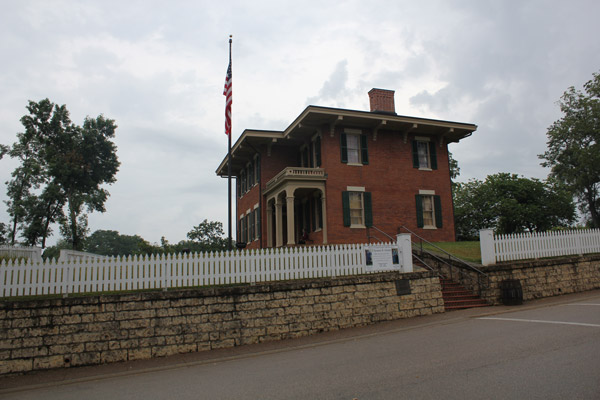
Heading up the hill toward Grant's official residence from his presidential years.
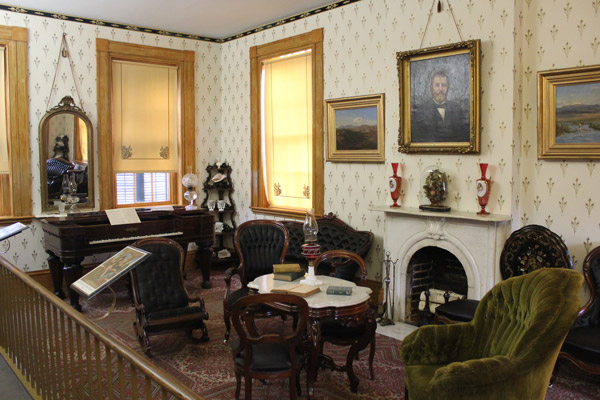
The parlor, where men could casually ingest both alcohol and dangerous amounts of lead.
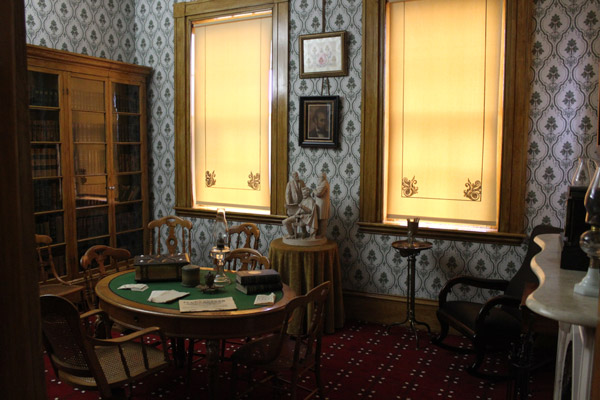
Grant's study, which is a veritable study in studies.
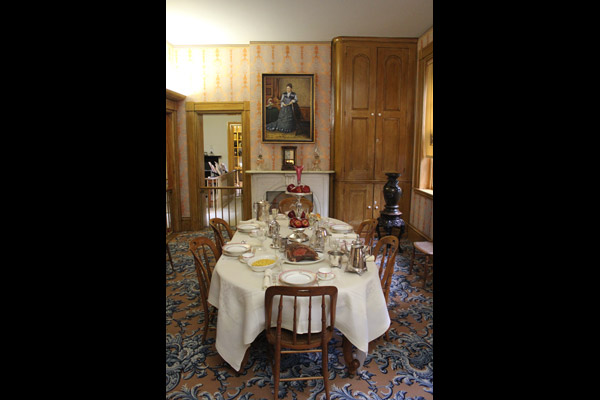
The Grants were apparently expecting me to stay for dinner.
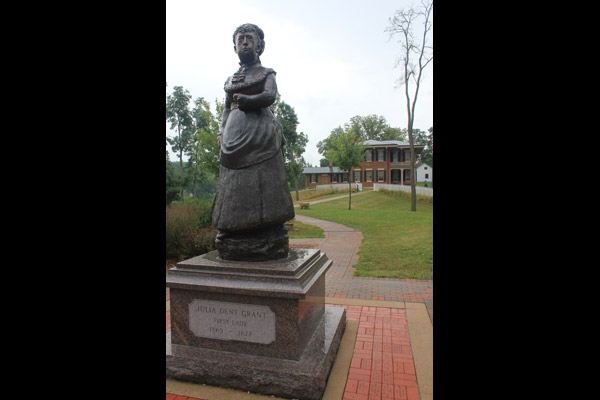
Julia Grant, the most beautiful person to ever marry Ulysses Grant.
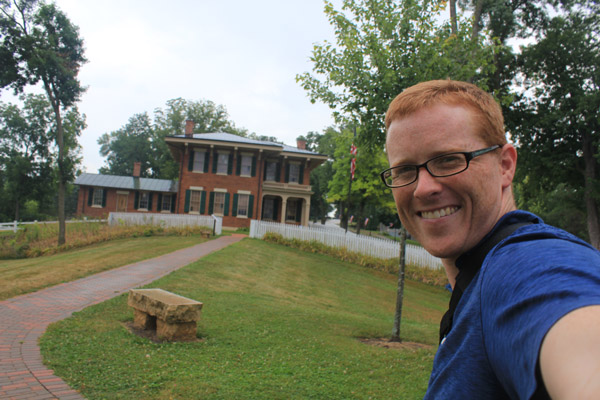
Photo evidence that I was in Galena that day, in case the courts ever ask.
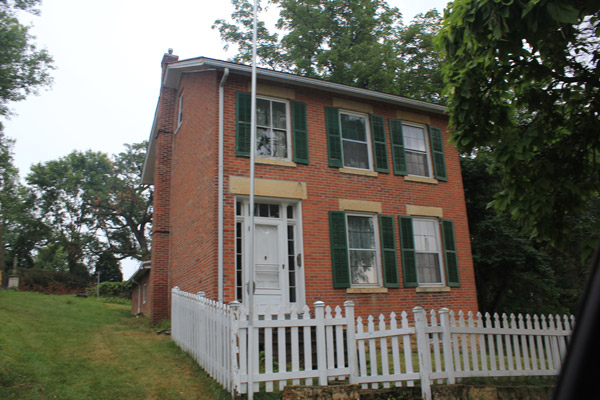
I'm pretty sure this High Street home was Grant's original Galena pad.
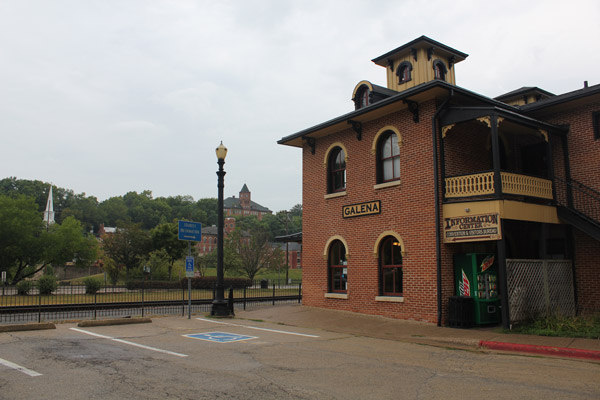
Strolling through Galena's historic district.
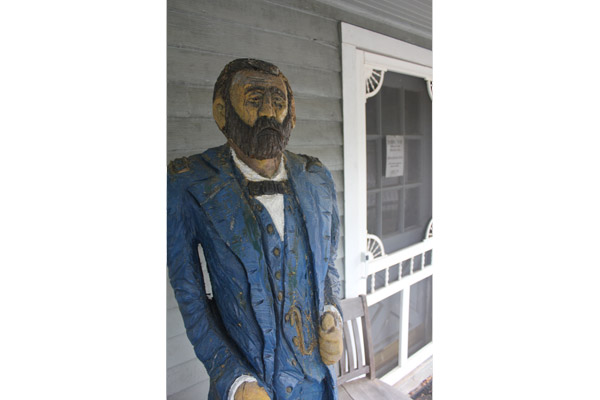
Yes, it's a cigar-store Grant. Miracles do happen.
So there's actually something worth seeing. I came into Galena from the north, crossing the Mississippi at Dubuque and following the river south through ridiculously beautiful countryside. I parked the car in front of Elihu Washburne's house -- the congressman was one of the 13 homebuyers, and for a few weeks he was Grant's secretary of State. Walking down to the river, I got a glimpse of Galena's historic district, which is quaint as hell. And then I walked up the steep hill to Grant's home, to see exactly what you get for saving the nation.
It's not bad at all. I had a nice guide named Vernetta, who walked me through the parlor and the study while sharing most of the information above. They let you peek into the bedrooms, and they encourage you to admire the fine woodwork and wallpapering throughout the building. It's not opulent -- that was never Grant's style -- but it is respectably pleasant. The only ugly thing about the site is a statue of Julia on the front lawn. Speaking strictly as an impartial historical observer, she was a hag. And from what I've read, she wasn't all that bright. There may be a reason her husband was willing to stare death in the face repeatedly.
They're trying to build out the Grant site into a historical district, because the lead trade isn't coming back anytime soon. (Fun story: In the Grant house, the have samples of special Galena-produced pottery, which had an irridescent glaze; it's a big collector's item because they stopped using the glaze once they figured out that everyone drinking from the bowls and jugs was getting lead poisoning.) There is a historical general store next door, and a block up the street I spotted an old building with a statue on the porch. It appeared to be a "cigar store" Grant. Considering Grant died of cancer from smoking too many cigars, this is one of the greatest things I've ever seen.
Born in the USA
In the early days of America, farms were more or less self-sufficient. You could eat the food you grew, make clothes from the animals you raised, force your children to serve as cheap labor and discreetly worship a pagan harvest deity away from the prying eyes of nosy neighbors.
Modernization changed all that. As people settled the Midwest, farms were smaller and more specialized, making them less likely to provide all your dietary needs. People got accustomed to cheaper, sturdier manufactured clothes and goods. The annoying law said you had to send your kids to school, and nice Christian churches started to spring up all over the place.
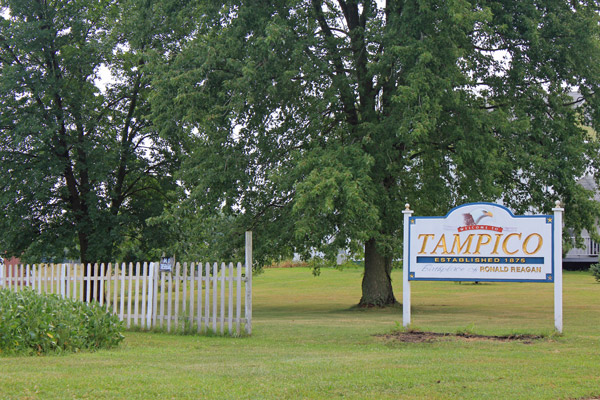
Welcome to Tampico, the town that sort of beat the Russians!
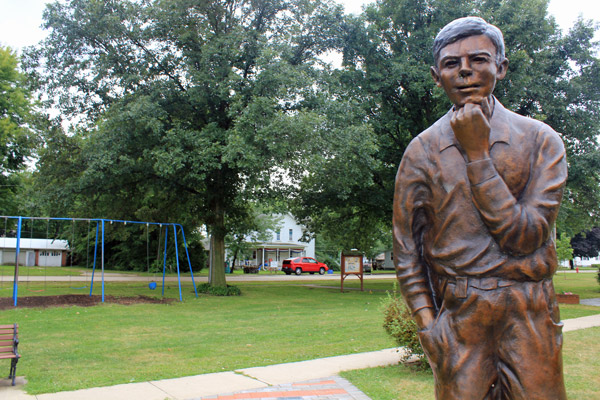
Tampico: I don't know why, but the artist clearly hated young Reagan.
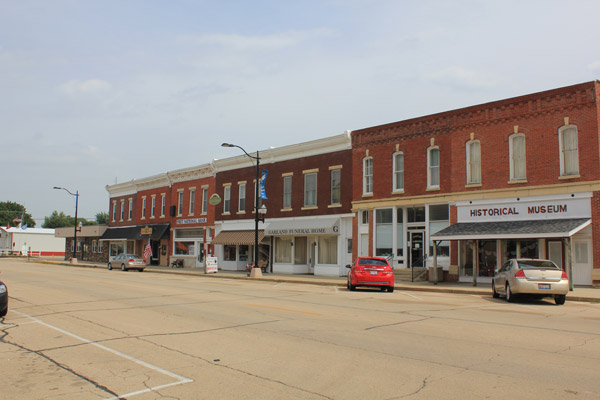
Downtown Tampico, across from the Reagan birthplace.
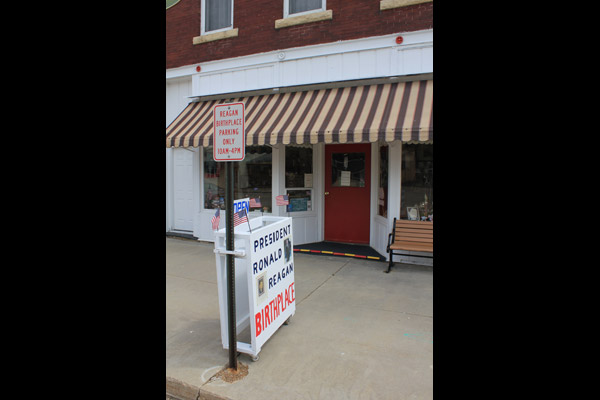
A closer shot of the museum entrance. There probably won't be a line.
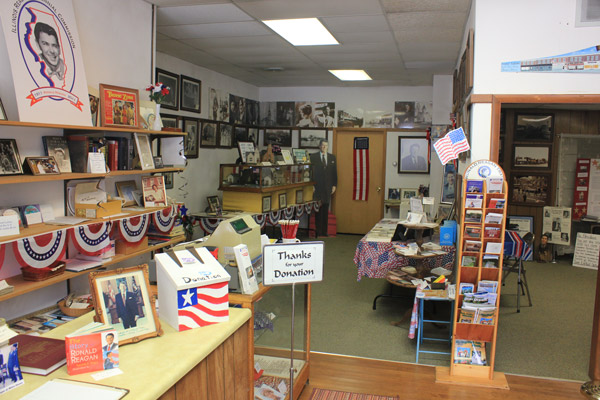
Tampico's number one stop for all your Ronald Reagan needs.
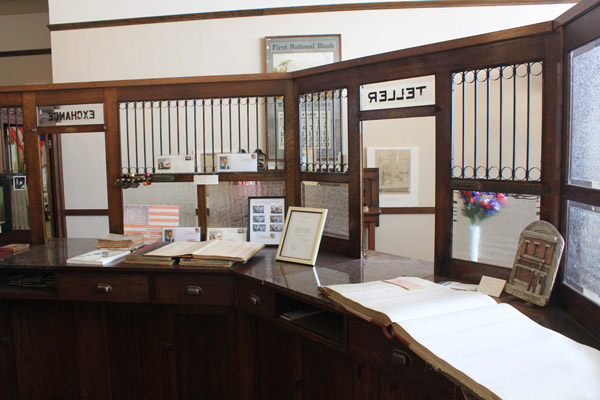
Checking out the re-creation of the Depression-era bank.
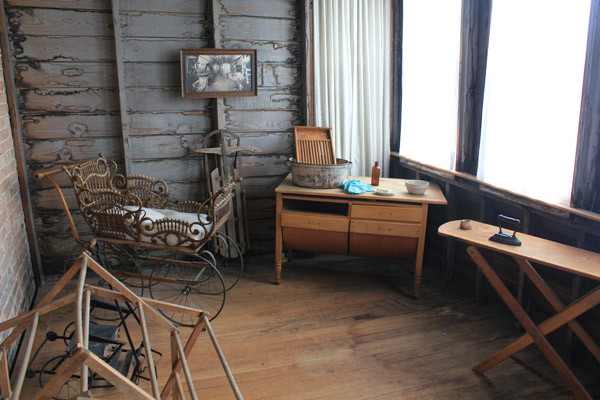
Inside the Reagans' old apartment, where Ronnie was born.
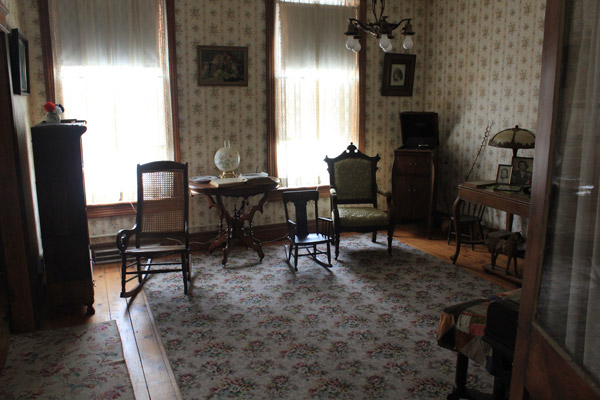
The Reagans' apartment, or at least a best guess at how it looked.
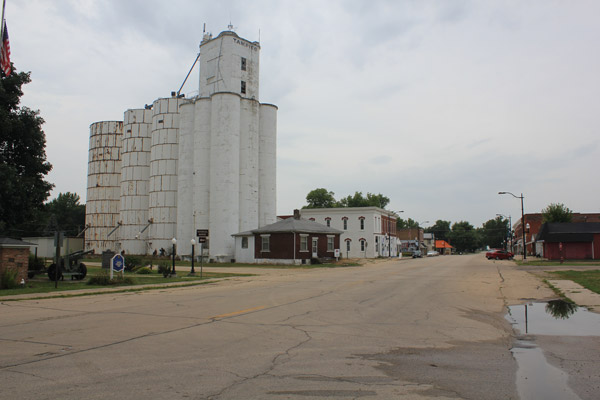
The rest of downtown Tampico. It makes Smallville look like Hugeville.
All these services had to have a delivery point, so America needed towns like Tampico, Ill. There were farms 10 miles in any direction, but downtown Tampico had a bakery, a grocery, a short-line railroad stop, a post office and a few churches. The population probably got a lot bigger on the weekends, when everyone came in from the farms to see (and talk crap about) their neighbors.
They also probably shopped at the Pitney Variety Store, for all their dry goods needs. Jack Reagan worked there, and in 1911 he was renting a six-room apartment above the bakery across the street. On Feb. 6, his wife gave birth to their second son, right there in the apartment. The Reagans weren't Dutch, but they came from a part of Illinois that was lousy with them -- Jack grew up in Fulton on the Mississippi, which still boasts a windmill. He supposedly thought his kid looked like a "fat little Dutchman," and the nickname stuck.
Ronald Reagan defeated an entire economic paradigm and starred in a movie with a chimpanzee. It's naturally interesting to see where such an amazing career began. Tampico is (cough) more humble today than it was in 1911 -- the population (800) is half the size, and the two-block downtown isn't exactly thriving. The Dutch Diner closed, the grain silo looks beat to hell and there isn't a dry goods store anymore.
But there is a museum. A very nice grandmother showed me around the bank that replaced the bakery; it's restored to a Depression-era look, when banks were at their absolute finest. There's also a room of Reagan memorabilia organized like the back room of an antique store. If you want, you can buy a T-shirt with a rainbow logo. Apparently, there was a double-rainbow right around the 1980 election, and someone snapped a photo so that one ribbon seems to end right on top of the apartment. Reagan supposedly kept the photo in his desk.
After that, it was upstairs to the apartment. They have everything decorated and organized like the Reagans might have, so it's nice but not extravagant. In a tribute to either terrible design or Midwestern friendliness, the back porch has a window that opens directly into the apartment next door. Apparently baby Ron was passed through the window to the neighbors when his mom needed to run some errands, and they let you climb through if you want. And yet they won't let you re-enact Reagan's birth. Sigh.
The Reagans left the apartment a few months after Ron was born. They probably lost their cleaning deposit after having a kid in the front bedroom, but they needed more space. They moved to a house a few blocks away, which is still privately owned and not available for tours, no matter how hard you stare menacingly at the front door. But you can enjoy the nearby park where Ron and his brother used to play on the antique cannons. That childhood romping inspired maybe the ugliest statue of a president ever made.
A few years later, Mr. Pitney sold his store, and the Reagans moved to Chicago. Jack was a hard-drinking guy with a spotty employment record, so relocations were a fact of life for the family -- the next few years they bounced around the state, even ending up back in Tampico after Pitney reacquired the business. The Reagans stayed over top of the dry goods store during their second stint, and now there’s a Reagan mural painted on the side of the building where the store used to be.
But it was just another pit stop. In 1920, Pitney decided that he trusted Jack enough to open a store called the Fashion Boot Shop. The family headed northeast, to a town on the Rock River called Dixon. They rented a house for $15 a month. After three years, the rent got jacked up, and they moved again -- the Reagans had five homes in Dixon. But Ron considered the first home his favorite, and it's the one they bothered to save.
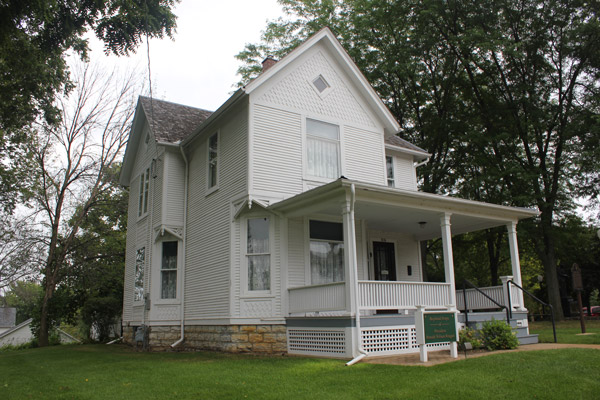
Dixon: For three years, this was the Reagan residence. But they moved a lot.
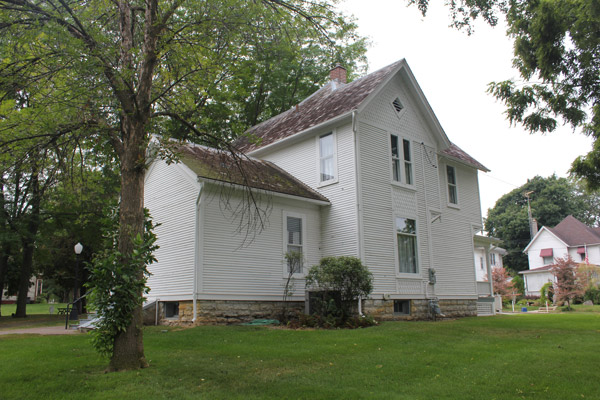
Another view of Reagan's fondly remembered boyhod home.
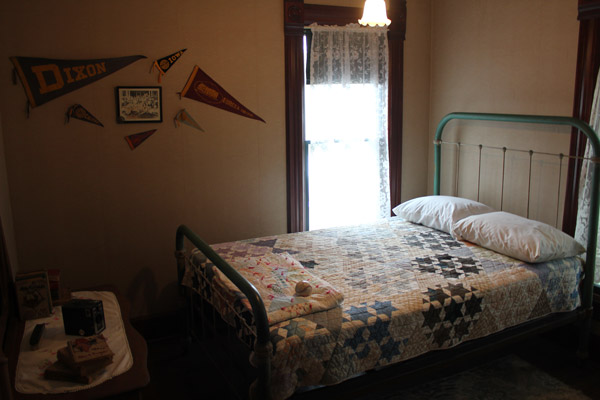
Reagan's room, restored to what was probably the World War I era.
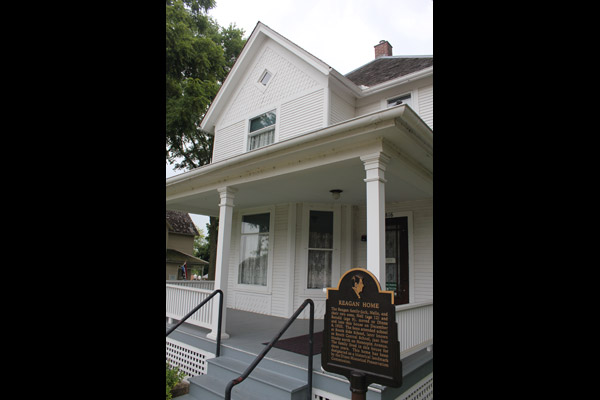
Getting in some porch time with the Reagan family.
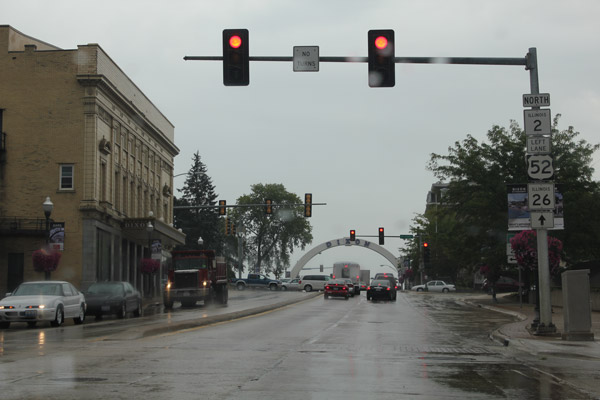
Heading toward downtown Dixon on a rainy day. It's huge, compared to Tampico.
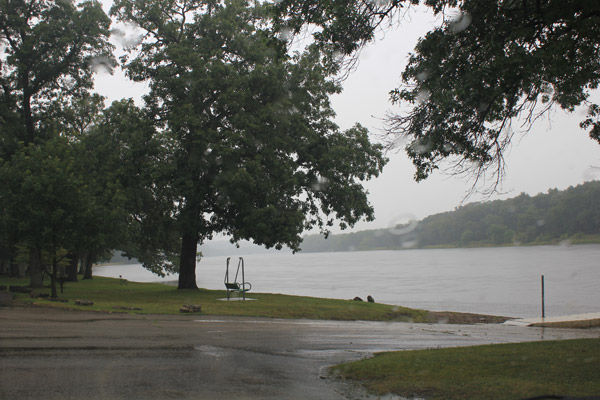
Lowell Park, where young Ronald pulled a lot of swimmers out of the water.
The Dixon site is fancier than the Tampico site. They have a separate building for a visitor center, and there's a nice informational video that can't be more than 30 years old, which is pretty good for a presidential site. Reagan visited Dixon in 1984 for his 73rd birthday. They renovated the home in advance of the party, and you're seeing the results today. The boys' bedroom was gussied up with boy-bedroom type things, and the dining room table is set the same way it was when Reagan ate there in 1984. Ron used to hide pennies under a tile near the fireplace, to keep them away from his older brother. He put a few more there on his visit, so they have the tile overturned. The could have left a few of Jack's empties around, but they didn't want to be totally authentic.
They share stories about the usual boyhood hijinks, but it's not a very big home. The whole experience takes about 30 minutes. I rounded out the day by driving to Lowell Park, where Reagan was a teenaged lifeguard. There might have been some kind of marker there, but it was pouring buckets. I was happy to sit in the car and stare at the river, like a frazzled private investigator wondering if the body would ever surface.
FUN REAGAN FACTS!!
- Jack Reagan is considered the second most influential Illinois shoe salesman, behind Al Bundy.
- Reagan's brother was nicknamed "Moon," allegedly after a popular cartoon character of the day. In reality, he was known for wearing assless chaps around the dry goods store.
- Reagan got in trouble with the Dixon police for shooting off fireworks at one of the Rock River bridges. He was fined $14.85, which was almost a month's rent for his family. This was the most expensive case of Reagan messing with rockets until Star Wars.
Don't Fear the Turtle
After seeing three presidential sites in a day, most people reach their USRDA for awesome American activities. I'm an unusual guy, so I decided to see more baseball after leaving Dixon. Some pre-vacation research indicated that there was another Midwest League game in Beloit, a Wisconsin city less than two hours away.
Both Dixon and Beloit are on the Rock River, so I skipped the interstates and took the scenic route to the Rodeway Inn in Beloit. It wasn't a Motel 6, but you can't live like a king every day. Once again, I bought my ticket online in advance -- for about $6 this time. That was also a mistake, as the clerk at the Rodeway offered tickets for free. Unlike the Cedar Rapids Kernels, the Beloit Snappers -- an Oakland A's affiliate -- were in last place with no chance of climbing out of the basement. Apparently, last-place single-A baseball in August is not much of a draw.
And neither is the Snappers stadium! While Cedar Rapids had a nice park, Beloit's stadium was a notch above a nice Little League complex. On leaving the dugouts, players have to walk through the concourse to get to a locker room that is probably very, very sad. You could purchase a hot dog, turn around and immediately greet the pitcher who just got yanked for giving up five runs in an inning. Considering the normal minor league salary, it would probably be good form to offer him your hot dog.
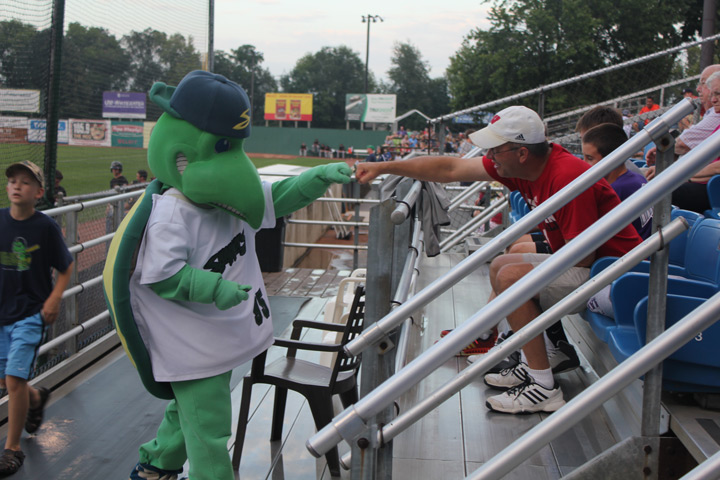
Nothing can top the craftsmanship of a minor league mascot costume.
There couldn't have been more than 200 people at the game, so the energy level was a bit down as the Quad City River Bandits (again!) beat the home team. The minor-league flourish this time was the walk-up music. Every time a River Bandit came to the plate, the music vaguely implied that the player was a woman. ("I Feel Like a Woman," "Barbie Girl," and "No Scrubs" were all featured.)
The best player name of the game belonged to Melvin Mercedes, the shortstop for the Snappers. The awesomeness of that name is augmented by the fact that there are actually two baseball players who go by Melvin Mercedes. The other Melvin pitches in the Detroit Tigers system. They probably get each other's mail all the time.
It was a low-key but fun night, and I closed it out the best way possible: buying a microwave cup of chili at a gas station. The Rodeway Inn supplies its patrons with microwaves, so I even enjoyed it the way god intended.
August 22-24, 2014
What'll Ya Have?
The actual reason I went to the Midwest in August 2014 was a bachelor party. A former roommate of mine defied the odds (and his personality) and got engaged to a lovely woman. After looking at several possible destinations for a bachelor weekend, he decided that Milwaukee was the place. Most people are baffled by that choice, but you'll have to ask Eric his exact reasoning yourself. I've heard some compelling theories, but most of them were offered by people at the bachelor party who were throwing Eric under the bus. They might be biased.
Personally, I had no problem with Wisconsin. As we've already discussed, the Midwest is full of minor league baseball and presidential sites. I had a solid presidential itinerary planned for more than a year, and the bachelor party was the flimsy pretext I needed to use it. I got to look like a good friend for traveling to an out-of-town bachelor party; I also got to see historic sites; and my wife never got dragged to Iowa. Everybody won!
On Friday morning, I drove from Beloit to the Milwaukee airport and turned in my rental car. Eric showed up about 40 minutes later, getting off a plane with his friend Andy. We were the vanguard, so we got a new rental car and went to see what Milwaukee is all about.
It's beige. The part of town we were driving through, high on a hill, had a bunch of buildings made of yellowish-brown bricks. The sky was overcast, so everything seemed a little bit drab. This wasn't remotely troubling, however, because Milwaukee is a city built around indoor recreation. Most your time outdoors is supposed to be spent face-down in a gutter.
Yes, Milwaukee is a city built around brewing. There's probably some manufacturing or tech companies that contribute to the economy, but no one bothers talking about them. On a weekend trip to the city, you will only hear about beer, and sometimes the legal troubles that might come from beer. Their entire service sector is probably built around DUI law. There are probably great historical reasons for the strength of the brewing industry. Mostly, people probably wanted to drink to cope with the inferiority complex the entire city has with Chicago.
Eric wanted to do a brewery tour, and after a quick poll we decided that the Miller tour would probably be too corporate and soulless. Instead, we decided to take the Pabst tour. Which involves no brewing whatsoever. Hipster, right?
Frederick Pabst was a German immigrant who worked as a steamboat captain on Lake Michigan. As a young man, he married a woman named Maria Best. After running his boat aground in December 1863 (allegedly to save it from a storm) he decided on a career change, probably because no one wants to ride with crashy McGee. His father-in-law owned a brewery, which Pabst bought half of. A few years later, dad sold the rest of the brewery to another son-in-law.
Pabst was really good at his new job, making him the world's most famous drinking captain, at least until Joe Hazelwood came along. The Best brewery became one of the largest in the world, helped in part by the Great Chicago Fire of 1871. When your whole city is reduced to ashes, you need a drink -- but that city's breweries were all smoking ruins. Milwaukee brewers developed a network of icehouses along the railroad tracks to help their beer survive the journey south. In every industry, the real secret to success is capitalizing on other people's misery. I'm pretty sure that's the lesson of the entire second year of business school.
Pabst eventually took control of the full company, and the name was changed from Best to Pabst. (The "B" in the Pabst logo honors the Best history.) At that point, the captain was probably the most powerful man in Milwaukee; he was one of those philanthropist millionaire types, like George Eastman or Andrew Carnegie, who could carry a whole city on their backs. He probably could have shot a prostitute in broad daylight and gotten a polite round of applause, but to his great credit, he never did. The brewery was a huge industrial complex spanning many city blocks, and the beer was actually considered really good. Pabst entered it in some prestigious competitions, and it actually won a few. Which leads us to the most SHOCKING REVELATION OF MY ENTIRE VACATION.
Pabst never won a blue ribbon.
Hogs get blue ribbons at state fairs. Beers get gold medals. The "blue ribbon" in PBR refers to ribbons that were tied around the neck of each Pabst bottle, a little decoration to make them stand out. So the next time someone tells you that Pabst won a blue ribbon at the 1893 Columbian Exposition -- as I did many, many times before this vacation -- feel free to smash your PBR can on their hipster skull.
When Pabst died in 1904, it made the front page of The New York Times -- he was that big a deal. And then, as with most stories centered on beer, things went slowly wrong. The Pabst company had many more decades of success. It survived Prohibition (by making things like Velveeta) and stayed popular with regular beer drinkers. But there was more competition from Budweiser and Miller. The company stopped being a juggernaut. In the mid-1980s a California company acquired Pabst, and national advertising tailed off. Market share kept slipping, and in 1996 the Milwaukee brewery shut down. Pabst still existed as a product, brewed under contractual agreements with other facilities -- and over the years the company had acquired the rights to Schlitz, Olympia, Lone Star, Colt 45 and several other classy beverages. But as a Milwaukee institution, it was dead.
Of course, that left the decaying remains of the brewery complex, which included seven blocks of huge brick structures with some fancy looking flourishes. It didn't take long for them to become an industrial eyesore.
And that's where we come in! Some guy obsessed with Pabst worked for several years to acquire or redevelop the brewery complex. I'll spare you the gory details, but after a series of deals, colleges took over a few of the buildings. Another is a luxury hotel (which still features some of the huge brewing equipment in the lobby area), and they have plans for the bottling plant (where the opening credits to "Laverne and Shirley" were filmed).
But the thing you actually see on the Pabst tour is "The Best Place." It has a small beer hall, covered with frescoes depicting the history of the Pabst company. This is where Pabst had many company functions. Now, it's where you sit for an hour, drinking Pabst products, eating pretzels and getting a presentation on the history we just covered. Our presenter was a very enthusiastic guy who clearly loved Pabst; he was proud of its local history and its status as one of the biggest American-owned beer brands. A few weeks after we took the tour, Pabst was sold to a Russian company, so the presentation might have changed a little bit. There's probably more distraught sobbing.
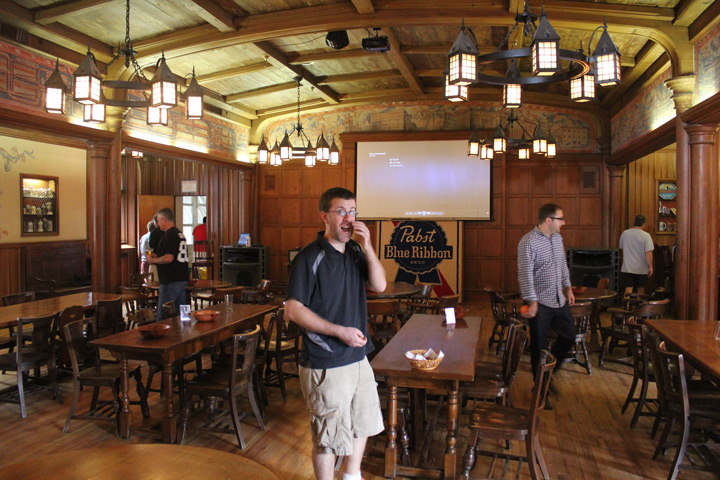
Inside the employee beer hall at the PBR tour.
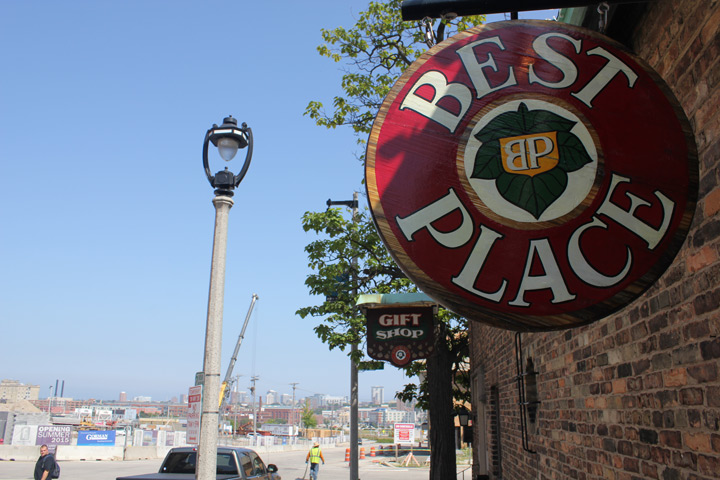
Simply the Best (Place). On the PBR tour.
We had a good time. The presentation was like a fun college lecture where you could actively drink beer, instead of just showing up while hung over. They have a fine gift shop with all kinds of memorabilia, and there's a courtyard with a statue of King Gambrinus, the patron saint of beer. He looks like the surly uncle of the Burger King mascot.
By the time we finished up at the Best Place, there were other people arriving in town for the bachelor party. We had to meet up with them and officially kick off the weekend, in classic Milwaukee style. Which is to say, we drove to another brewery tour.
Lakefront Brewery (naturally) sits on the Milwaukee River, in what used to be a small power plant. It's a small but growing operation; they have apparently done some innovative things with organic beer, and they also have a nice event space where people can drink their faces off.
The tour at Lakefront is a little more conventional. At every microbrewery tour, a fat beer-drinking white guy with piercings and a beard is your guide. He makes occasionally bawdy jokes. The brewing process is basically the same everywhere you go, and so is the equipment. The point is to shuffle through for about half an hour, laugh at the bearded guy's jokes and then use all the tokens that get you beer samples.
The samples at Lakefront were very fine, and we also enjoyed their Friday night "fish fry," which has very little to do with fish. The highlight of the visit was the appetizers. We identified ourselves as tourists and asked the waitress which one was the most "Wisconsin." This is how we ended up with fried cheese curds.
Fried cheese isn't a new thing, but I didn't realize how meaningless and empty my existence was before fried cheese curds. Next to fried cheese curds, the mozzarella stick is the unemployed brother-in-law of the fried cheese family. The one that keeps asking for loans for great business opportunities that his friends at the docks are letting him in on. If I had regular access to fried cheese curds, I would live a much shorter and greasier life.
I chased the cheese curds with some macaroni and cheese, to slow my blood down to a crawl. It was a fine and relaxing start to the bachelor party weekend, and we were going to need our energy for the evening's activity: drinking more beer and eating more cheese while watching a baseball team named for people who make beer. Milwaukee is consistent, if nothing else.
Miller Time
If you're looking for a nice way to spend a bachelor party, and you don't want to have a long and impossible-to-win argument about strippers, you should go to a baseball game. My bachelor party was at a Phillies game, and the one time I had to plan a bachelor party it involved a Pirates game. It involves beer and sports, and at major-league prices you can easily spend just as much money as you would shoving cash down the underwear of an Eastern European human-trafficking victim.
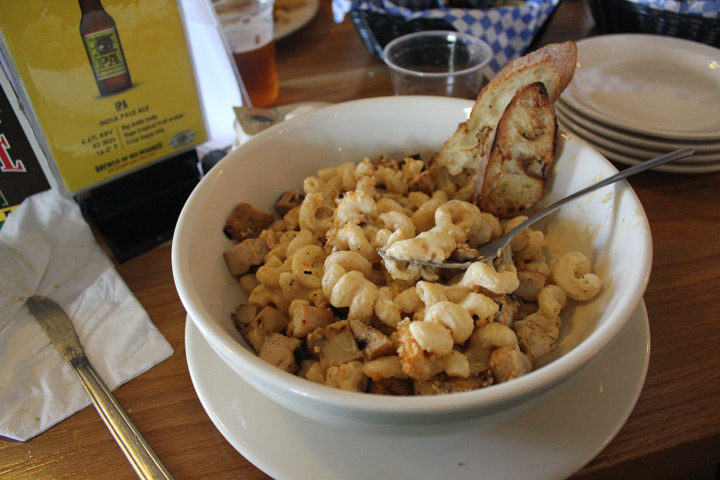
Fried cheese curds at Lakefront Brewery. The best!
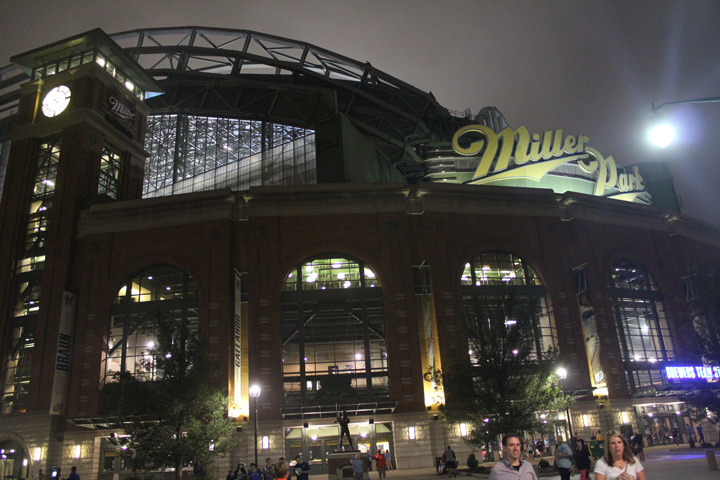
One of baseball's coolest parks, in my estimation.
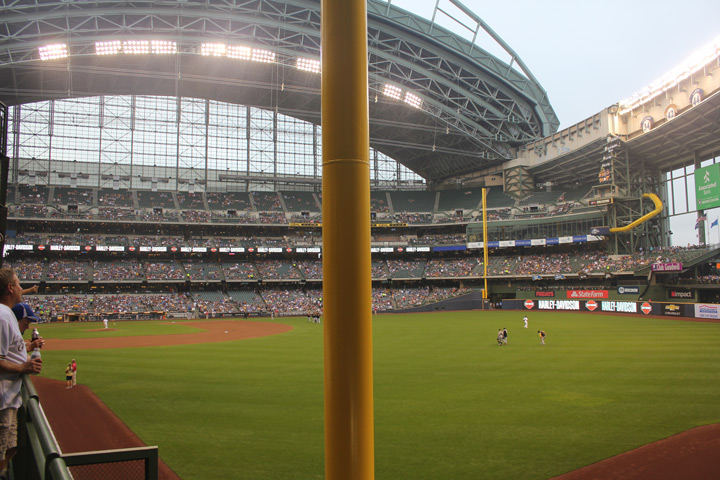
The view from the cheap seats, not far from the notorious Ryan Braun.
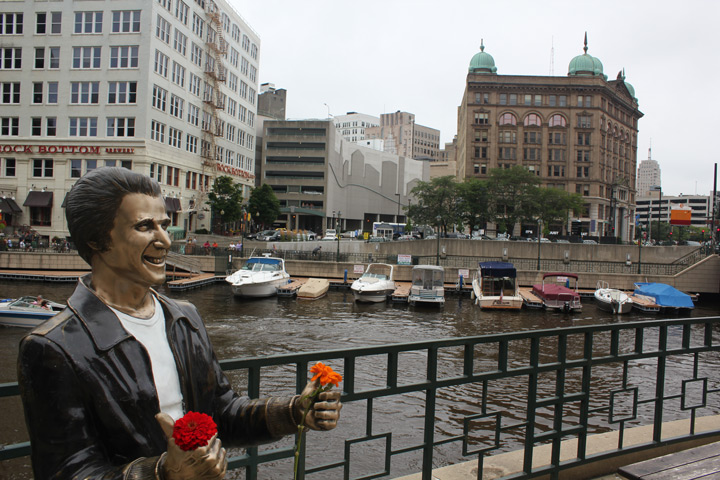
On the way out of town, a quick visit to the Fonz in downtown Milwaukee.
Eric wanted to go to a Brewers game, which means he graciously fulfilled my longtime goal of seeing Miller Park. It opened in 2001, and every time I saw it on TV it looked like a cool place to see a game. I can now confirm that it is a cool place to see a game, thanks to some unusual features.
- Pre-gaming! The Brewers do more to encourage pre-game partying than any other franchise I've seen. They have a really big tailgate scene in the parking lot, and there's also a strip of divey sports bars really close to the stadium. Each one of those dives has a shuttle bus that takes you to the stadium if you buy a drink; then they pick you up and take you back to the bar after the game, so you can drink more and get your car from the free neighborhood parking spot where you left it. You should probably politely ignore that the Brewers seem to be encouraging massive amounts of drunk driving, as it's part of the local culture.
- The roof! Miller Park has a distinctive retractable roof -- two giant "fans" meet behind home plate, and they can open up to meet in the middle. When they aren't deployed the fans look like enormous metal arches, so they give the stadium a ridiculous tall profile. We didn't get to see the roof close, although fog was pouring into stadium. Fog might contain the spirits of the undead, and therefore you should never anger it.
- The statues! We didn't walk around Miller Park in its entirety, but we did see some interesting statues outside. One was Bob Uecker, the famed sitcom star who also happens to do Brewers play-by-play when he's not rolling around in a huge pile of his Mr. Belvedere money. He's a national treasure. The other was Bud Selig, the former Brewers owner and outgoing commissioner of Major League Baseball. Apparently you can spot Robin Yount and Hank Aaron (who played for the Braves, not the Brewers) if you walk around the park more, but I think most kids are really inspired by the image of Bud Selig.
- Bernie Brewer! There's a long history behind Bernie, the Brewers' mascot. He's a big Germanic-looking guy with a moustache. Back when America was still cool, Bernie used to celebrate every Brewers homer and victory by going down a slide into a giant beer mug. Nowadays Bernie has a "dugout," a big elevated platform in left field that includes cheerleaders. There's still a slide for Bernie to use. But he lands on a platform, and not in giant beer mug. Sigh.
- Sausage races! A few teams now use a "race" to entertain fans during an inning break. I believe the Brewers were the first to do it with live-action mascots, in this case sausages. I've seen the racing presidents and racing pierogies, but you haven't really lived until you've seen five people in giant phallus-shaped costumes jog around the warning track in front of 40,000 screaming fans. Finally, I know what the Roman Empire was all about.
It really is a great stadium. If you don't drink Miller, you have many fine Miller-affiliated alternatives, like Leinenkugel. Milwaukee specializes in the kinds of foods you're supposed to eat at baseball games, so that's another plus. And if you're fortunate enough to sit in right field, you might get to be breath-takingly close to Ryan Braun, the most beloved athlete of his generation. As it turns out, we were witness to the great collapse of 2014, which saw the Brewers fall from first place in the NL Central and miss out on either wild card spot. They were playing the Pirates, and Andrew McCutcheon hit one of the longest home runs I've ever seen in person. Maybe next year, guys.
There were other bachelor party activities that rounded out the weekend, but in the interest of discretion, and because they didn't involve tourism, I'll spare you the details. Instead, I leave you a picture of a statue on the Milwaukee river walk. You can decide for yourself if it's Fonzie or Cesar Romero playing the joker. I could go either way.
